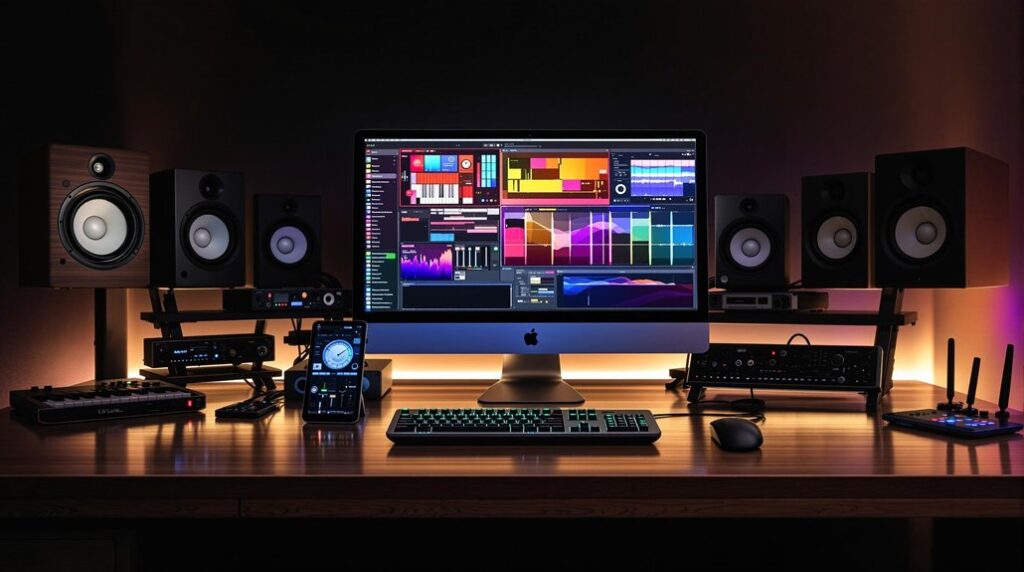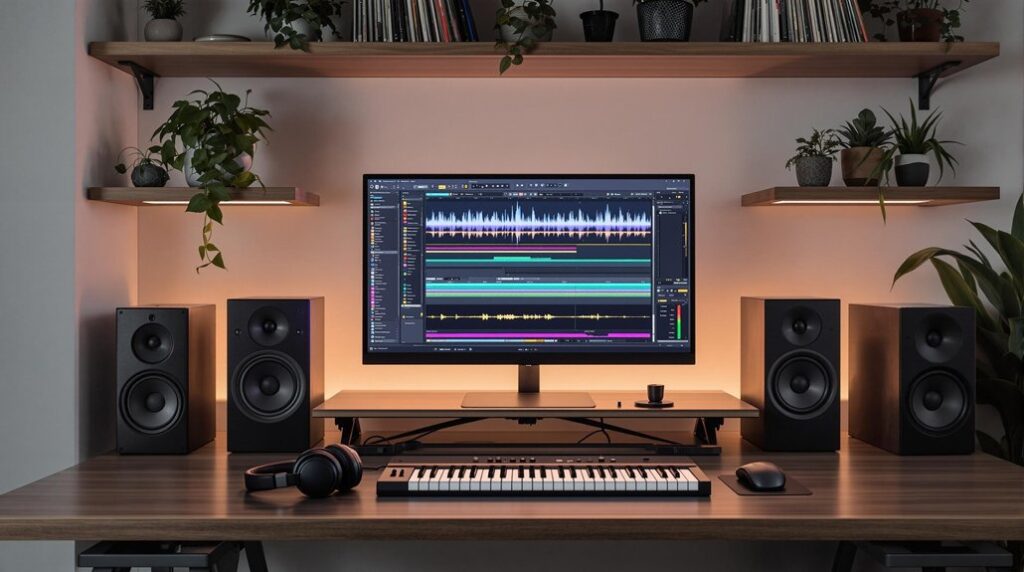Ableton Live Lite is tailored for beginners, featuring limitations that set it apart from higher versions like Standard and Suite. It restricts users to eight audio and MIDI tracks, in contrast to the unlimited tracks available in advanced editions. The Lite version includes only 21 built-in audio effects and fewer than 300 sounds, while other versions offer extensive libraries and more complex effects. Additionally, Lite users face restrictions on external instrument integration. These features aim to simplify music production, making it accessible for newcomers. For further insights into its functionalities and upgrade paths, you may find valuable information.
Key Takeaways
- Ableton Live Lite is limited to eight audio and MIDI tracks, while other versions like Intro allow up to 16 tracks.
- Live Lite includes fewer than 300 sounds and instruments, whereas Intro offers over 700 sounds for greater creativity.
- The effects in Live Lite are basic, while more advanced versions support a wider range of complex audio effects.
- Users of Live Lite face restrictions on integrating external instruments, which is more flexible in higher editions.
- Live Lite is designed for beginners, providing a simplified interface and a quicker learning curve compared to more advanced versions.
Overview of Ableton Live Editions
Ableton Live offers a range of editions designed to meet the varying needs of users, from novices to seasoned professionals.
Ableton Live Lite serves as an entry point for beginners, providing a limited selection of features, including a maximum of eight audio and MIDI tracks. This edition includes a constrained array of built-in sounds and effects, making it suitable for users who are just starting.
In contrast, Live 10 Standard and Live 10 Suite offer extensive capabilities, allowing for unlimited audio and MIDI tracks, and access to vast libraries of instruments, plugins, and sound packs. Users seeking to enhance their productions may find inspiration through best free plugins that can elevate their musical projects.
These advanced editions cater to professional producers who require robust tools for complex projects, highlighting the significant differences between the Lite version and its more advanced counterparts.
Key Features of Ableton Live Lite
The features of Ableton Live Lite reflect its role as an entry-level version of the software, tailored for users who are new to music production.
This streamlined music production software provides essential tools while maintaining a user-friendly interface, enabling beginners to create without feeling overwhelmed.
Key features include:
- A maximum of eight audio and MIDI tracks for basic project creation.
- 21 built-in audio effects to enhance sound quality.
- A library with fewer than 300 sounds and instruments, sufficient for initial explorations.
- A simplified interface designed for intuitive navigation.
- Required authorization to save and export projects, emphasizing account management.
Additionally, users can benefit from plugin management features that help streamline their workflow and ensure efficient use of resources.
Installation and System Requirements
When preparing to install Ableton Live Lite, it is essential to confirm that your system meets the necessary requirements for peak functionality.
For Mac users, Mac OS X 10.11.6 or later is required, while Windows users need Windows 7 (SP1), 8, or 10 (64-bit). The minimum RAM requirement is 4 GB, although 8 GB is recommended for maximum performance.
Additionally, users must verify adequate internal hard drive space to accommodate the software and additional content.
To avoid compatibility issues, it is advisable to download Ableton Live Lite from the official Ableton website, assuring that the latest version is installed.
It is also prudent to verify that your operating system is updated to the latest version prior to installation.
Comparison With Other Versions
For users evaluating their options in digital audio workstations, understanding the distinctions between Ableton Live Lite and its more advanced counterparts is essential.
- Ableton Live Lite is limited to eight audio and MIDI tracks.
- The Intro version allows up to 16 tracks and includes over 700 sounds.
- Live Lite offers only basic effects and instruments, while the Intro version supports more complex effects.
- Users of Live Lite face restrictions on external instrument integration.
- The upgrade path from Live Lite to more advanced versions often includes discounts, making it appealing for aspiring producers.
- DJs using software like Djay Pro may find that AI-powered mixing enhances their performance capabilities, a feature not available in Live Lite.
User Experience and Feedback
While many users initially perceive Ableton Live Lite as a basic version of the software, their experiences reveal its considerable value as an entry-level tool for music production.
The simplified interface allows beginner producers to create music swiftly, avoiding the overwhelming complexity of full versions. Feedback from users underscores Live Lite’s effectiveness in facilitating a smooth shift to advanced editions, as its limited track count and effects encourage creativity and experimentation.
Positive testimonials emphasize its intuitive design, resulting in a quicker learning curve. In addition, the supportive community surrounding Ableton Live Lite offers abundant resources and tutorials, greatly enhancing the user experience for novices, making it an ideal starting point in their music production journey. Furthermore, the inclusion of essential features like clip launching and recording provides a foundational understanding of the software’s capabilities.
Frequently Asked Questions
What Is the Difference Between Ableton Live Lite and Regular?
Ableton Live Lite features significant track limitations, basic audio editing, and MIDI capabilities compared to regular versions. The user interface is simplified, facilitating a lower learning curve, while plugin support and performance tools are restricted.
What Limitations Does Ableton Lite Have?
Ableton Live Lite imposes limitations on audio and MIDI tracks, effects, and instrument selection. Users miss advanced features like Max for Live, automation capabilities, and enhanced session and arrangement views, alongside restricted export options and plugin support.
What Does Ableton Live Lite Offer?
Ableton Live Lite offers essential music production tools, including audio editing, MIDI functionality, software instruments, and effects processing. Its user-friendly interface supports live performance, though track limitations and export options restrict advanced projects and compatibility features.
Is Ableton Live Lite Better Than Reaper?
In the Ableton Live versus Reaper comparison, user experience varies considerably. While Ableton Live Lite excels in workflow efficiency and community support, Reaper offers superior feature set, audio quality, and MIDI capabilities, attracting advanced users despite a steeper learning curve.
Conclusion
In conclusion, Ableton Live Lite serves as an entry-level version of the Ableton Live software, designed to meet the needs of novice users while offering essential features for music production. Its limitations in track count and device availability distinguish it from the Standard and Suite editions, which provide more extensive capabilities and content. Overall, Ableton Live Lite offers a valuable introduction to the Ableton ecosystem, facilitating the development of foundational skills in music creation and performance.




